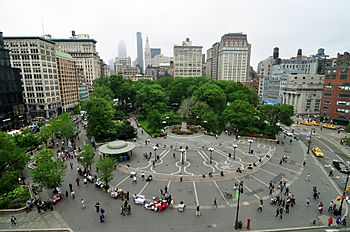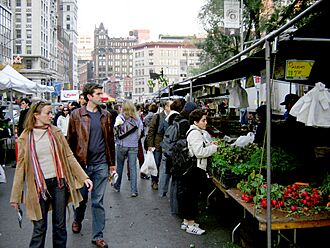Union Square, Manhattan facts for kids
|
Union Square
|
|

Union Square seen from 14th Street in May 2010
|
|
| Location | Manhattan, New York City, U.S. |
|---|---|
| Built | 1882 (laid out c. 1832) |
| Architect | Frédéric Auguste Bartholdi, et al. |
| NRHP reference No. | 97001678 |
Quick facts for kids Significant dates |
|
| Added to NRHP | December 9, 1997 |
| Designated NHL | December 9, 1997 |
Union Square is a famous spot in Manhattan, New York City. It's where two important roads, Broadway and the old Bowery Road (now Fourth Avenue), met a long time ago. That's why it's called "Union Square"—it's where they "united"!
The main part of Union Square is a park. It's surrounded by 14th Street to the south and 17th Street to the north. On the sides are Union Square West and Union Square East. The New York City Department of Parks and Recreation takes care of the park.
Union Square is close to many cool neighborhoods like the Flatiron District and Greenwich Village. Many buildings for The New School and New York University are nearby. On the east side, you'll see the tall Zeckendorf Towers. On the south, there's a building with a unique wall sculpture and digital clock called Metronome. The park also has statues of famous people like George Washington, Marquis de Lafayette, Abraham Lincoln, and Mahatma Gandhi.
You can easily get to Union Square using the New York City Subway at the 14th Street–Union Square station.
Contents
History of Union Square
How the Square Was Created
Long ago, the area where Union Square is now was mostly farmland. In 1811, city planners were mapping out New York City. They noticed that Broadway and the Bowery Road met at a sharp angle. It would have been hard to build houses there. So, they decided to create a public square instead.
At first, it was called Union Place. In 1815, the state officially made it a public park. Later, in 1831, a man named Samuel Ruggles convinced the city to make the square bigger and rename it "Union Square." He also helped develop the land around it. The park officially opened in July 1839.
A fountain was built in the center of the square in 1842. It received water from the Croton Aqueduct. By 1845, the area was becoming popular with wealthy families. The park was designed with paths and trees. In 1872, famous landscape designers Frederick Law Olmsted and Calvert Vaux helped replant the park.
Over time, Union Square changed from a quiet residential area to a busy commercial one. Many fancy homes were replaced by businesses. Stores like Tiffany & Co. were once here before moving to other parts of the city.
Union Square's Theater Scene
In the 1870s, Union Square became New York City's first major theater district. It was called "The Rialto," like a famous commercial area in Venice. The Academy of Music opened here in 1854.
Before the Civil War, theaters were mostly on Broadway and the Bowery. After the war, shopping areas grew, pulling theaters uptown. This created a new theater strip on Broadway between 14th and 23rd Streets, right around Union Square.
This new theater scene also brought many businesses that supported the shows. There were shops for props, costumes, and scenery. Talent agents and theatrical boardinghouses also popped up. Union Square became a lively entertainment hub. Eventually, the theater district moved further uptown to what we now call "Broadway."
Early 1900s Changes
By the early 1900s, Union Square was a major transportation center. Several train lines and the new New York City Subway (opened in 1904) served the area. It also became a big wholesale district with many office buildings.
Many old homes in Union Square were turned into apartments for immigrants and workers. Artists also moved into the area, setting up studios. By the 1920s, the south side of 14th Street felt like an extension of Greenwich Village.
Park Renovations in the 1910s and 1920s
In 1910, city officials planned to add a firefighters' memorial. In 1913, construction began on the 14th Street–Union Square subway station right under the park. A large section of the park was closed and dug up for this work. The city promised to fix up the park after the station was done.
By 1916, the subway station was finished, and park restoration began. In the late 1920s, the park was raised by about three feet for more subway expansion. Plans also included moving statues and building a concert area with a bandstand. The park's renovation was mostly done by 1931.
Late 1900s Revival
By the 1950s, many big stores had left Union Square, and the area started to decline. The last major retailer, S. Klein, closed in 1975. The empty store site was a sad reminder of how the area had changed.
In 1982, a $1.5 million plan was announced to fix up Union Square Park. The first part of this renovation finished in 1985. It included removing hedges, adding more lights, and new subway entrances. These improvements, along with new buildings like the Zeckendorf Towers, helped real estate values go up.
Union Square was named a National Historic Landmark in 1997. This was mainly to honor it as the place where the first Labor Day parade was held. In 1998, Mayor Rudy Giuliani announced plans to spend $2.6 million to expand the park. This included adding a small "pocket park" at the southeast corner, which was finished in 2000.
Early 2000s and Beyond
After the September 11 attacks in 2001, Union Square became a main gathering spot for people to mourn. People left candles and photos in the park, and vigils were held.
North End Renovation
In 2008, a big renovation started on the north end of the park. The goal was to make the playground better, improve the public plaza, and fix up the old band shell. There were some disagreements about having a restaurant in the pavilion, but a judge allowed it in 2009. The Pavilion restaurant opened in May 2014.
Future Plans
In 2021, the Union Square Partnership suggested a $100 million plan to improve Union Square even more. This plan would close off nearby streets to make the park 33 percent bigger. It would also add more benches and lights, improve restrooms, and fix up the dog run.
Buildings Around Union Square
Many interesting buildings surround Union Square. Some of them are:
- The Lincoln Building at 14th Street.
- The Bank of the Metropolis at 31 Union Square West.
- The Decker Building at 33 Union Square West.
- The Century Building (where Barnes & Noble is) at 33 East 17th Street.
- The W New York Union Square hotel, which used to be the Germania Life Insurance Company Building.
- The Daryl Roth Theatre, which was once the Union Square Savings Bank.
- The Zeckendorf Towers, a large apartment complex.
- One Union Square South, which has the cool Metronome sculpture.
Art and Statues

Union Square is home to several important statues:
- A large statue of U.S. President George Washington on a horse. It was put up in 1856 and was the first public sculpture of its kind in New York City in a long time.
- The Marquis de Lafayette statue, created by Frédéric Auguste Bartholdi (who also designed the Statue of Liberty!). It was dedicated in 1876.
- The statue of Abraham Lincoln, located near the north end of the park.
- A statue of Mahatma Gandhi was added in 1986 in the southwest corner.
- The Union Square Drinking Fountain (1881) is a special fountain with a figure of Charity helping a child. It was donated to encourage people to drink water instead of alcohol.
- The Charles F. Murphy Memorial Flagpole, also called the Independence Flagstaff, was put up in 1930.
In October 2023, a sculpture of a New York sewer alligator called N.Y.C. Legend was shown in the square. It was made by a Swedish artist, Alexander Klingspor.
There's also a double line of trees along 17th Street with a plaque. It's a memorial to the victims of the Armenian genocide.
Markets and Businesses
Public Markets
In 1976, a group called the Council on the Environment of New York City (now GrowNYC) started the Greenmarket program. This allowed local farmers to sell their fresh fruits, vegetables, and other products directly to people in the city. The first Greenmarket at Union Square was a big success!
Today, the Union Square Greenmarket is very popular. It's open all year on Mondays, Wednesdays, Fridays, and Saturdays. Many farmers from about 90 miles away come to sell their goods. During busy times, over 250,000 customers visit each week! You can find more than a thousand different kinds of fruits and vegetables there.
Union Square also hosts the Union Square Holiday Market every November and December. Over 150 vendors sell handmade crafts. About two million people visit this market each year! In the summer, there's also a Night Market for food.
Local Businesses

Union Square is a great meeting spot because it's central and has many subway lines. There are lots of restaurants and bars around the square, including some very fancy ones. Many big stores like Barnes & Noble and Staples have opened here.
The W New York Union Square hotel is at the park's northeast corner. The Hyatt Union Square New York hotel is at the southeast corner.
Fun Activities
Street Chess
If you visit Union Square, you might see people playing chess! Many street chess players moved their games here from Washington Square Park. They play fast games of chess with people passing by for a few dollars. It's fun to watch or even try a game yourself!
Freestyle Hip-Hop
Since 2012, Union Square has been a regular spot for a hip-hop freestyle rap gathering called Legendary Cyphers. People from all over the city and tourists come to watch and join in the freestyle rapping.
Union Square Partnership
The Union Square Partnership (USP) is a group formed in 1984. It helps improve the area and has been a model for similar groups in New York City. The Union Square Partnership also provides free public Wi-Fi in Union Square.
Education Nearby
The Washington Irving Campus is a block east of Union Square Park. It used to be a large high school. Now, it houses several different high schools, like Gramercy Arts High School and the International High School at Union Square. An elementary school also opened there in 2013.
Gallery
-
14th Street–Union Square station entrance -
Union Square West, with the Bank of the Metropolis Building and Decker Building in 2011 -
Former Germania Life Insurance Company Building, now the W New York Union Square Hotel -
Former Union Square Savings Bank, now the Daryl Roth Theatre -
Zeckendorf Towers with the renovated north plaza of the park, and the Con Ed Building
See also
 In Spanish: Union Square (Nueva York) para niños
In Spanish: Union Square (Nueva York) para niños




















